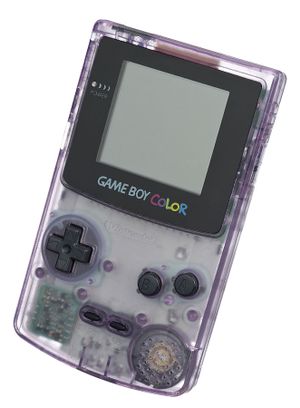Difference between revisions of "Game Boy Color"
| Line 21: | Line 21: | ||
| successor=[[Gameboy_Advance|Game Boy Advance]] | | successor=[[Gameboy_Advance|Game Boy Advance]] | ||
}} | }} | ||
| + | |||
| + | = Introduction = | ||
| + | |||
| + | The '''Game Boy Color'''{{efn|{{nihongo|ゲームボーイカラー|Gēmu Bōi Karā}} in Japan}} ('''GBC''') is a [[handheld game console]] manufactured by [[Nintendo]], which was released on October 21, 1998 in Japan and was released in November of the same year in international markets. It is the successor of the [[Game Boy]]. | ||
| + | |||
| + | The Game Boy Color features a [[RGB color model|color screen]]. It is slightly thicker and taller and features a slightly smaller screen than the [[Game Boy Pocket]], its predecessor. As with the original Game Boy, it has a custom [[8-bit]] processor made by [[Sharp Corporation|Sharp]] that is considered a hybrid between the [[Intel 8080]] and the [[Zilog Z80]]. The spelling of the system's name, ''Game Boy Color'', remains consistent throughout the world with its [[American English]] spelling of color. | ||
| + | |||
| + | The Game Boy Color's primary competitors in Japan were the grayscale 16-bit handhelds [[Neo Geo Pocket]] and the [[WonderSwan]], though the Game Boy Color outsold these by a wide margin. [[SNK]] and [[Bandai]] countered with the [[Neo Geo Pocket Color]] and the [[Wonderswan Color]] respectively but this did little to change Nintendo's sales dominance. With Sega discontinuing the Game Gear in 1997, the Game Boy Color's only competitor in the United States was its predecessor, the Game Boy, until the short-lived Neo Geo Pocket Color was released in August 1999. The Game Boy and Game Boy Color combined have sold 118.69 million units worldwide making it the 3rd best selling system of all time. It was discontinued in 2003, shortly after the release of the [[Game Boy Advance SP]]. | ||
Revision as of 22:11, 8 January 2019
 | |
 Atomic Purple version of the Game Boy Color | |
| Manufacturer | Nintendo |
|---|---|
| Product family | Game Boy line |
| Type | Handheld game console |
| Generation | Fifth generation |
| Release date |
JP: October 21, 1998 NA: November 18, 1998 EU: November 23, 1998 AUS: November 27, 1998 |
| Retail availability | 1998–2003 |
| Discontinued | March 23, 2003 |
| Units sold | Worldwide: 118.69 million, including Game Boy units |
| Media | ROM cartridge |
| CPU | Sharp LR35902 core @ 4.19/8.38 MHz |
| Display | LCD 160 x 144 pixels, 44 mm × 40 mm (1.7 in × 1.6 in) |
| Online services | Mobile System GB |
| Best-selling game | Pokémon Gold and Silver, approximately 14.51 million combined (in Japan and the USA). |
| Backward compatibility | Game Boy |
| Predecessor | Game Boy |
| Successor | Game Boy Advance |
Introduction
The Game Boy ColorTemplate:Efn (GBC) is a handheld game console manufactured by Nintendo, which was released on October 21, 1998 in Japan and was released in November of the same year in international markets. It is the successor of the Game Boy.
The Game Boy Color features a color screen. It is slightly thicker and taller and features a slightly smaller screen than the Game Boy Pocket, its predecessor. As with the original Game Boy, it has a custom 8-bit processor made by Sharp that is considered a hybrid between the Intel 8080 and the Zilog Z80. The spelling of the system's name, Game Boy Color, remains consistent throughout the world with its American English spelling of color.
The Game Boy Color's primary competitors in Japan were the grayscale 16-bit handhelds Neo Geo Pocket and the WonderSwan, though the Game Boy Color outsold these by a wide margin. SNK and Bandai countered with the Neo Geo Pocket Color and the Wonderswan Color respectively but this did little to change Nintendo's sales dominance. With Sega discontinuing the Game Gear in 1997, the Game Boy Color's only competitor in the United States was its predecessor, the Game Boy, until the short-lived Neo Geo Pocket Color was released in August 1999. The Game Boy and Game Boy Color combined have sold 118.69 million units worldwide making it the 3rd best selling system of all time. It was discontinued in 2003, shortly after the release of the Game Boy Advance SP.